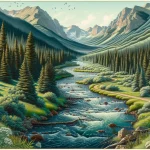Colorado is renowned for its incredibly diverse and stunning landscapes, from the soaring Rocky Mountains to high desert plains and red rock canyons. This natural beauty makes the state a premier road trip destination, with many iconic drives and byways showcasing the best of Colorado’s scenery. In addition to jaw-dropping vistas, these routes provide opportunities to experience local culture, outdoor adventures, wildlife viewing, and historical sites that bring Colorado’s rich history to life.
In This Article
This article explores the allure of Colorado’s iconic drives and what makes them bucket-list worthy, from world-famous routes like the Million Dollar Highway to hidden gems like the West Elk Loop. It also offers tips for planning your Colorado scenic drive to fully immerse yourself in the state’s unique road trip experience.
TL;DR
- Colorado's diverse landscapes make it an iconic road trip destination with drives like the Million Dollar Highway.
- Scenic drives showcase stunning vistas and opportunities for outdoor adventures, culture, and history.
- Tips are provided for planning your own Colorado scenic drive experience.
Diverse Landscapes and Scenery
Crisscrossing Colorado by car allows you to experience diverse landscapes, from high alpine tundra to red rock canyons, lush forests, and high desert terrain. The state’s scenic drives and byways traverse extremely varied terrain, taking you through some of the most beautiful scenery in the American West.
The San Juan Skyway loop in southwest Colorado offers a condensed showcase of iconic Colorado landscapes. One moment you’re winding between towering sandstone formations in a Monument Valley-esque desert, the next climbing through aspen-filled mountains and meadows with wildflower displays before descending along sheer cliffs and passing waterfalls pouring into box canyons.
Further north, Trail Ridge Road crosses the Continental Divide in Rocky Mountain National Park, topping at 12,183 feet. This high alpine drive above the tree line provides almost 360-degree views of craggy mountain peaks and the forested valleys and parks below.
Historic and Modern Marvels
In addition to beautiful scenery, journeys along Colorado’s iconic routes allow you to immerse yourself in history. Many follow historic trails used by Native Americans, early pioneers, prospectors during the gold rush era, and modern settlers. Interpretive signs explain this long history and what you see from your car window.
For example, the Santa Fe National Historic Trail traces the rugged route American Indians and Europeans took when settling in the West. You’ll find remnant wagon ruts, abandoned homesteads, and trading posts dotting the landscape. Or take the Silver Thread Scenic Byway through historic mining towns where gold and silver booms shaped Colorado’s cultural identity.
While celebrating the past, some drives also showcase Colorado’s modern marvels. The Mount Blue Sky Scenic Byway (formerly Mount Evans Scenic Byway) climbs to the highest paved road in North America at 14,264 feet, with views spanning over 100 miles on clear days. Along the Colorado River Headwaters Byway, the mighty Colorado River emerges as a small stream from a subalpine valley.
Outdoor Adventure Along the Way
With so much public land and wilderness, Colorado’s scenic drives aren’t just about what you see from the road. They also provide access to get out and actively experience the landscapes with hiking trails, climbing areas, fishing holes, and winter sports opportunities right off the highway. Chances are that places like Estes Park, Grand Junction, Cripple Creek, Crested Butte, and Idaho Springs have an historic byway that will take you right to them.
The 82-mile West Elk Loop, one of Colorado’s hidden gems, winds through the West Elk Mountains and Gunnison National Forest, with numerous recreation access points. Tack on a hiking detour to explore wildflower-filled meadows, crystal-clear lakes, and even a backcountry hot spring oasis at Conundrum.
Meanwhile, the San Juan Skyway contains segments of the famed Colorado Trail, which intersects with the Continental Divide National Scenic Trail. Trailheads and campsites are along the way for thru-hikers and day-trippers to enjoy alpine vistas. The scenic byway also accesses winter recreation areas like Purgatory and Silverton Mountain for skiing and heli-skiing.
But you don’t have to venture too far to find great road trips. For example, the entrance to the Pikes Peak Highway is just 15 minutes from Colorado Springs.
Diverse Ecosystems and Wildlife
With elevations ranging from 4,500 feet to over 14,000 feet, Colorado’s scenic drives traverse numerous distinct ecosystems and life zones. This diversity supports a wide variety of wildlife species, and seeing animals in their natural habitat adds a memorable element to scenic drives.
The Flat Tops Trail Scenic Byway is a prime area to spot impressive bull elk with huge antler racks, especially during their fall mating season. And Dinosaur Diamond Prehistoric Highway gets its name from following the fossil-rich beds where dinosaur bones were first discovered. Look for interpretive areas explaining the Jurassic environment that dinosaurs roamed.
At higher elevations, sightings may include bighorn sheep navigating rocky slopes, pikas and marmots that may dart across the road, soaring eagles, and, if you’re extremely lucky, even a glimpse of the elusive snow leopard.
When to Go
Colorado’s scenic drives offer year-round appeal, with landscapes transforming through spring, summer, fall, and winter.
Summer showcases Colorado’s alpine beauty with wildflowers blanketing mountain meadows. Temperatures are mild, and the days are long for extended sightseeing. Just be prepared for summer thunderstorms.
Fall is a spectacular time as the aspens turn brilliant gold, contrasting with the evergreen pines. Crisp air and smaller crowds add to the appeal of routes like Independence Pass.
Even in winter, certain roads remain open, though snow may require chains or 4WD vehicles. The solitude and chance to see the mountains coated in snow are magical. Note that high passes like Trail Ridge typically close from October through May.
Spring is another transitional period as winter snow melts, fueling waterfalls and swollen streams. Wildlife like bighorn lambs and black bear cubs emerge while wildflowers explode in lower elevations. Just be prepared for variable conditions.
Planning Your Colorado Scenic Drive
Armed with the basics of what makes Colorado’s scenic drives so special, here are some tips for planning your own epic road trip adventure:
Pick a region:
Choose a home base like southwest, central, or northern Colorado based on which landscapes and recreational opportunities appeal most. Scenic drives often form loops allowing you to start and end in one area.
Check road conditions:
Some mountain passes close seasonally, while others require high clearance or 4WD vehicles. Always check weather and road reports to pick the right route and comfort level for your vehicle.
Allow plenty of time:
It’s tempting to cram in as many miles and activities as possible, but moving too fast means you’ll miss out. Instead, take your time to soak in views, stop at overlooks, and explore trails and towns along the way.
Prepare accordingly:
Carry chains, emergency gear, extra gas, food, and water in case you get stranded in remote areas. Respect weather extremes like afternoon lightning or winter snowstorms at high elevations.
Focus explorations:
Identify particular outdoor activities, cultural sites, or ecosystems you want to experience, then select scenic drives that provide access. This helps you focus your adventure beyond just snapping photos out your window.
FAQ
Here are answers to some common questions about road-tripping Colorado iconic routes:
What are the most iconic scenic drives in Colorado?
Some of the most iconic and popular routes include Trail Ridge Road, Million Dollar Highway, Mount Blue Sky Scenic Byway, San Juan Skyway, Peak to Peak Scenic Byway, and Independence Pass.
What’s the best scenic drive for fall colors?
The Peak to Peak Highway and Guanella Pass Scenic Byway provide front-row seats to Colorado’s fall foliage spectacle of golden aspens. Independence Pass is another excellent option.
Which scenic drives are best for winter activities?
Try the Mount Evans Scenic Byway, Trail Ridge Road in Rocky Mountain National Park, or the Silver Thread Scenic Byway to access top ski resorts and snow adventures.
Where are the best wildlife viewing opportunities?
Good spots to see wildlife include Dinosaur Diamond Scenic Byway, Highway of Legends, and Colorado River Headwaters National Scenic Byway, where you may spot elk, bighorn sheep, and rare bird species.
What should I know about driving mountain passes?
Steep narrow roads, sharp drop-offs, and fast-changing weather can make mountain passes challenging. Drive cautiously, use lower gears, and don’t follow other vehicles too closely.






